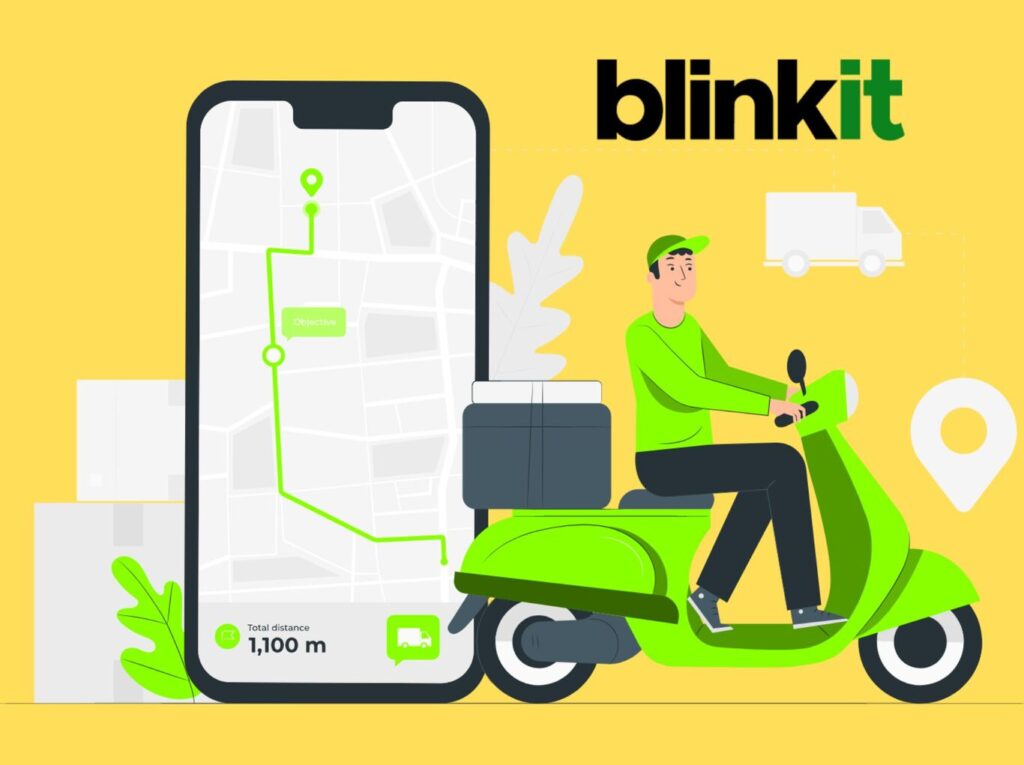
Revolutionizing Quick-Commerce
Blinkit, initially known as Grofers, has transformed the landscape of quick-commerce in India. While Amazon and Flipkart dominate the traditional e-commerce sector, Blinkit’s rapid growth in the ultra-fast delivery market has turned heads and opened new avenues for direct consumer engagement. This case study explores Blinkit’s journey, strategic pivots, operational management, and its evolving competitive stance, offering key business insights for students, entrepreneurs, and professionals alike.
1. Identifying Market Gaps: How Blinkit Disrupted the Delivery Market
Business Lesson: Recognize Gaps and Innovate to Solve Real Problems
In 2020, as the demand for ultra-fast delivery grew, Blinkit saw an opportunity in providing essential goods within minutes. Unlike traditional e-commerce that prioritizes variety and low prices, quick-commerce capitalizes on convenience and immediacy. Blinkit aimed to meet the demand for groceries and essentials in real-time by deploying a unique dark store model.
- Dark Store Model: Blinkit established local warehouses or “dark stores” in densely populated urban areas, drastically reducing delivery times and maximizing convenience.
- Data-Driven Location Choices: Each Blinkit dark store is strategically located based on demand density and local demographics, ensuring high utilization and frequent order turnover.
Insight: Businesses can achieve market differentiation by addressing a unique pain point — in Blinkit’s case, instant access to essentials. Recognizing gaps in consumer needs can lead to pioneering strategies.

2. Operational Efficiency and Unit Economics
Business Lesson: Scale Operations by Optimizing Every Aspect of Cost
One of the biggest challenges in the quick-commerce model is cost. Running a network of dark stores with a short delivery window increases expenses for inventory, rent, and delivery personnel. Blinkit optimized unit economics through two main strategies:
- Increasing Average Order Value (AOV): In the past, low AOV (average order value) hindered profitability. Blinkit worked to increase AOV by incentivizing bundled purchases, upselling, and using data analytics to offer complementary products.
- Efficient Last-Mile Delivery: Delivery expenses were streamlined by deploying riders to optimal routes. Blinkit also introduced dynamic pricing for low-demand hours, thereby balancing the cost-effectiveness of deliveries.
Insight: Operational efficiency in quick-commerce requires a focus on AOV and last-mile delivery optimization. Blinkit’s unit economics model is a testament to how cost structures can improve with scale and data-driven logistics.
3. Marketing Strategy: Emphasizing Convenience Over Cost
Business Lesson: Tailor Your Marketing to Highlight Core Benefits
Traditional e-commerce platforms emphasize price competitiveness, but Blinkit’s marketing focus is on time-saving convenience. Their ads convey the promise of fast deliveries in relatable, real-life scenarios, positioning Blinkit as an invaluable resource for busy urban consumers.
- Targeting Affluent, Time-Poor Customers: Blinkit targets consumers who prioritize time over cost, such as working professionals and urban families. This audience is less price-sensitive and values the convenience of instant access.
- Emotional Messaging in Campaigns: Blinkit’s marketing strategy focuses on scenarios where quick delivery is essential, creating a memorable brand association with speed and convenience.
Insight: By understanding its unique value proposition, Blinkit was able to create marketing messages that differentiated it from giants like Amazon, which emphasizes selection and price.

4. Technological Infrastructure: Leveraging Data for Seamless Operations
Business Lesson: Use Technology to Drive Real-Time Operational Decisions
With a high-volume, time-sensitive business model, technology underpins Blinkit’s efficiency. They use AI and data analytics to predict demand patterns, manage inventory, and assign delivery tasks. Blinkit’s tech team developed proprietary algorithms to optimize:
- Inventory Management: Based on regional consumption trends, Blinkit stocks popular items, reducing stockouts and unnecessary inventory.
- Rider Efficiency: AI-driven route optimization helps riders cover more orders in less time, reducing per-delivery costs.
Insight: A robust tech infrastructure that uses data-driven decisions can offer a significant edge in high-demand environments. Blinkit’s example shows that technology isn’t just an enabler but a differentiator.
5. Scaling with Flexibility: Expanding Beyond Groceries
Business Lesson: Diversify Product Offerings to Broaden Market Appeal
While Blinkit initially focused on groceries, it has since expanded to categories such as household goods, personal care, and electronics, transforming its dark stores into mini-warehouses with a diverse range of items.
- Quickly Adaptable Product Mix: Blinkit continuously adjusts its offerings based on market demand and seasonal trends. For example, during lockdowns, it expanded its range of home essentials and health products.
- Dynamic Pricing and Product Expansion: Blinkit introduces high-margin items in different categories, which not only increases profitability but also offers convenience for consumers looking for more variety.
Insight: Quick-commerce companies can increase revenue by diversifying product offerings, allowing them to reach new consumer segments and optimize each delivery’s revenue potential

6. Competitive Strategy: Building Barriers Against Amazon and Flipkart
Business Lesson: Carve Out a Niche by Creating Unique Value Propositions
Amazon and Flipkart’s core strengths lie in extensive catalogs and nationwide delivery networks. Blinkit, on the other hand, differentiates itself by offering hyper-localized and instant delivery. Here’s how it has protected its niche:
- Customer Loyalty through Convenience: By prioritizing 10-20 minute deliveries, Blinkit creates a convenience that traditional e-commerce cannot easily replicate.
- Subscription and Loyalty Programs: Blinkit offers membership programs for frequent users, building a loyal customer base that sees Blinkit as irreplaceable for immediate needs.
Insight: Businesses can create competitive advantages by focusing on specific niches that large competitors cannot easily replicate. Blinkit’s focus on instant delivery has created a strong brand presence in the quick-commerce segment.
Key Business Lessons for Entrepreneurs and B-School Students
- Identify and Exploit Market Gaps: Success in a saturated market often comes from addressing an unmet need rather than competing directly. Blinkit focused on immediate deliveries for everyday needs, carving out a distinct place in the market.
- Drive Efficiency through Technology: Blinkit’s tech stack optimizes routing, inventory, and delivery processes, demonstrating how technology can streamline operations even in high-frequency businesses.
- Build for the Right Audience: By targeting time-sensitive consumers, Blinkit maintained premium pricing and avoided price wars. Knowing your target market’s priorities can guide business strategies.
- Focus on Core Strengths for Competitive Advantage: Blinkit didn’t try to replicate Amazon’s catalog but instead focused on speed and local convenience. Differentiation through unique value propositions can create strong customer loyalty.
- Adaptability and Scalability: Blinkit’s expansion into new product categories shows the importance of agility in business, enabling it to serve more needs without straying from its core promise of quick delivery.
Conclusion: Blinkit’s Potential for Growth in the Quick-Commerce Industry
Blinkit’s journey from an online grocery to a quick-commerce leader showcases how innovation in operational efficiency, technology, and customer targeting can drive success in a competitive landscape. For students and professionals, Blinkit’s strategy is an instructive example of finding gaps in the market, leveraging technology, and creating a strong competitive advantage. The quick-commerce model continues to evolve, but Blinkit’s early leadership offers a roadmap for succeeding in an ultra-fast, convenience-driven sector.
References:
- “Blinkit’s Genius Strategy that Stunned Amazon and Flipkart,” Think School, YouTube.
- Financial insights on quick-commerce from Economic Times and JM Financial reports.
- Industry analysis on dark stores and logistics in quick-commerce from Moneycontrol.
Leave a Reply